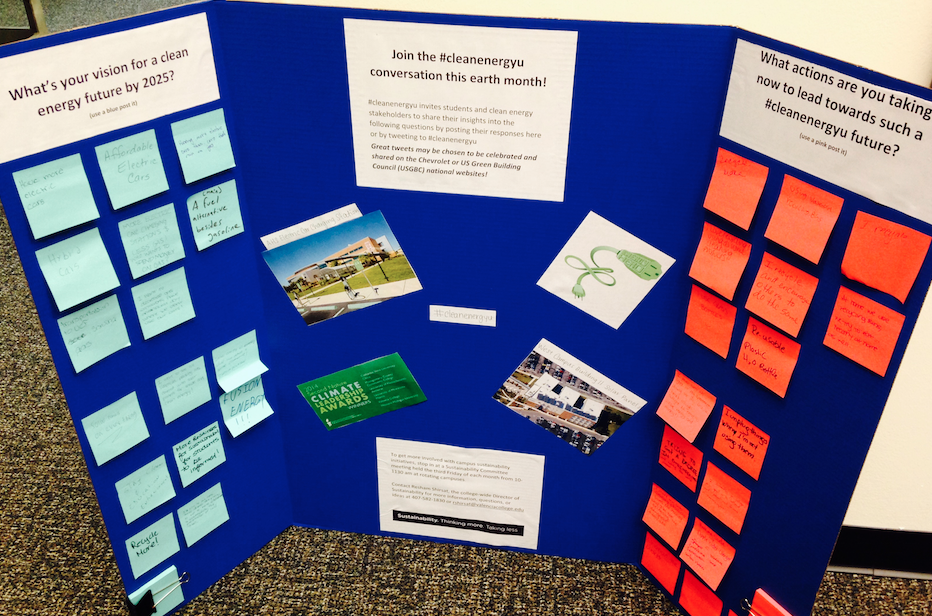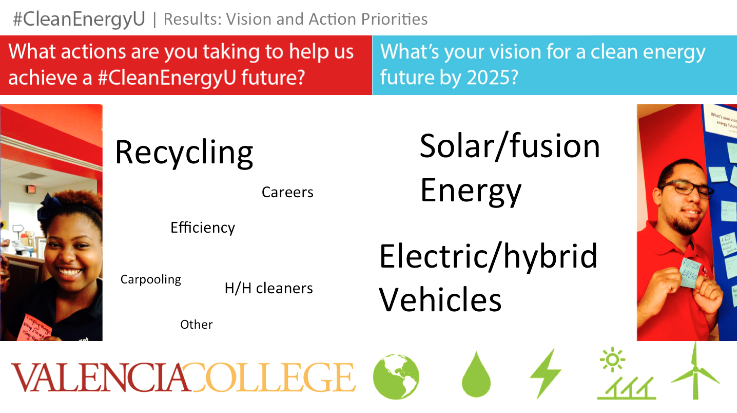Code Green Solutions


Valencia College students used post it notes to share their ideas for achieving a clean energy future.
As our #cleanenergyu conversation gets underway again this Earth Month, students from across many U.S. campuses are sharing their vision for a 2025 clean energy future by convening post it wall conversations. Valencia College (FL) has a stunning track record of reducing its GHG emissions through its clean energy leadership – with a performance that opened the door to earn carbon credit funding including through Chevrolet. So Resham Shirsat, Valencia’s Director of Sustainability, was intrigued to learn more about Valencia students’ vision for a 2025 clean energy future and initiated the first #cleanenergyu post-it wall conversation to probe their views!
Any campus or organization can share their vision for a 2025 clean energy future: so why not consider how this #cleanenergyu post-it wall conversation might help your community gain insights into realizing its priority 2025 goals? What insights might you learn?
Resham shares her experiences with us here …
Sue Hall: So Rea, how did you go about engaging Valencia College students in the #cleanenergyu post-it wall conversation?

A cluster map of students’ vision and action ideas highlighting common priorities (the size of text reflects the number of votes).
Resham Shirsat: Valencia College celebrated Earth Day activities at different campuses from April 6-14. So to convene the #cleanenergyu conversation post-it wall activity, we used a cardboard trifold with one #cleanenergy question on the two sides. The first question read “What’s your vision for a clean energy future by 2025?” and the second question read “What actions are you taking now to lead toward such a clean energy future? We dedicated two different post-it colors for the two different questions. In the middle we posted some simple directions and hashtag information along with some sustainable energy pictures from campus. We left the display unattended at events and invited students to participate on a voluntary basis.
SH: So that sounds like a pretty simple set up: how did you motivate students to post their ideas?
RS: We also made it clear that great tweets may be chosen to be celebrated and shared on the Chevrolet or USGBC website(s). Already their posts are live on the Chevy newswire announcement! As a two year associate college, many of our students are more mature and don’t tweet regularly; so we’ll post some of their photos from our sustainability college twitter account too!
SH: What was students’ vision for their 2025 clean energy future?
RS: After clustering the results we found that students’ vision had a very strong focus on electric cars, followed by sustainable alternative energy sources such as solar and in one case, fusion. As a two year commuter institution, students are all too familiar with the costs of purchasing and maintaining a vehicle and fuel as they travel some distance to/from class. Indeed, Associate Colleges’ average GHG emissions profile is heavily skewed to transportation-based emissions as a result. So what was particularly intriguing to see was students’ desire for electric vehicles and infrastructure – which not only aligns well with our demographic but was central to students’ 2025 vision.
SH: So what might you plan to do with this electric vehicle vision focus?
RS: Valencia College already has some charging stations on campus. But it would be great if we could now expand upon this post-it wall information (through student focus groups) to provide justification for further funding and expansion of the electric vehicle infrastructure (charging stations, campus and city charging stations locations map, etc.) on campus. So this post-it wall process has also been a great way for me, as a sustainability director, to listen to and document students’ voices – and bring them directly to the administration to advocate for their priorities.
SH: What did you learn from students’ action posts?
RS: On the action side there was a clear majority that stated they recycle to support a clean energy vision. Although there is a clear connection between waste reduction and emissions reduction (think of the lower energy demands from recycling aluminum cans), I do not think students picked this action because they are knowledgeable about this connection. I personally believe from my experience that students primarily think of recycling as the action they can take to create a better world. As educators and change agents, we must educate students on the hundreds of individual actions they can take toward building a sustainable future.
Furthermore we need to go further by educating young people on the ways they can create systemic change to get to the root of the problem instead of one or two simple behavioral changes, which will never be enough to result in the changes that their vision indicates are needed.
SH: What inspired you in their actions?
RS: I loved seeing that two people stated that their career choice will support a sustainable future! As educators, preparing students for their future work is core to our mission: so thinking about career choices as a way to realize a clean energy aspiration connected these students’ action and vision goals in a compelling and exciting way!
SH: What did you personally learn?
RS: I was surprised how worthwhile an exercise it is to compare the actions and visions (after clustering) side by side to see if there is alignment. Unfortunately I did not see clear alignment between students’ actions and vision – but this “gap” is perhaps not surprising at an early stage of this discussion. Again as educators this reveals the need for students to think more holistically and be provided more knowledge on actions they can take. So it inspires us as faculty to deepen our commitment to strengthen sustainability education into our curricula.
—
Interestingly, Resham also identified some creative ways to use the #cleanenergyu post-it wall results to raise students’ electric vehicle priorities to the College’s attention for stronger infrastructure investment. So the classic “gap” that can arise between our “action” and “vision” priorities is already closing again at Valencia College!
So how might the #cleanenergyu post-it conversation help you align your community’s clean energy action and vision priorities?
Join Valencia College in building your own post-it wall conversation and share your results and insights at #cleanenergyu!